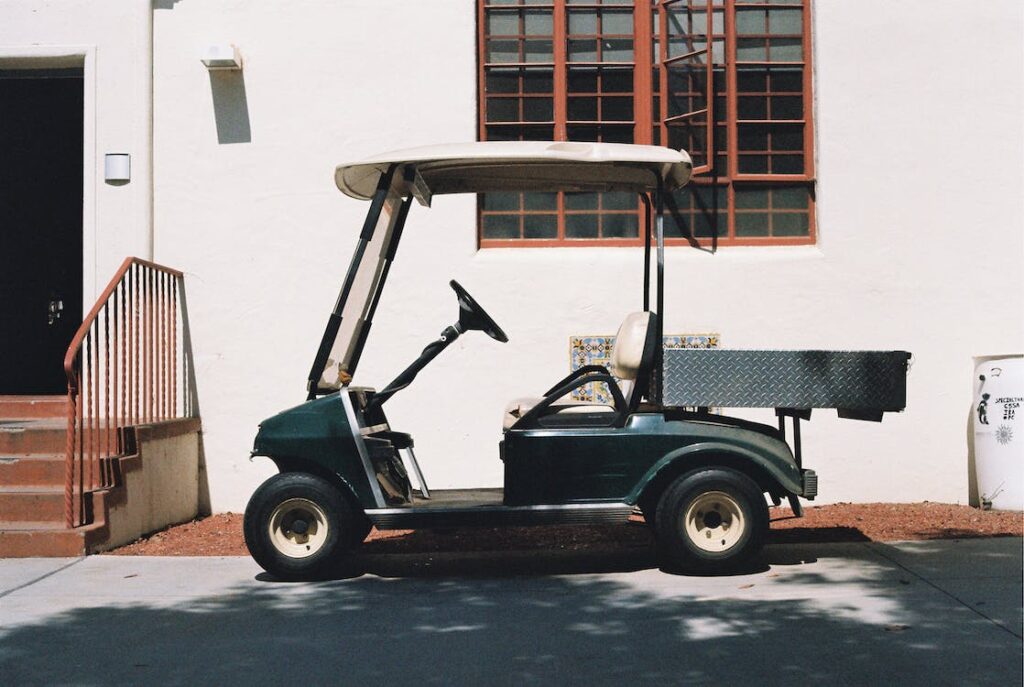Golf cart batteries are a key component that allows you to play full 18-hole rounds. Understanding their lifespan and how to maximize it is important knowledge for any golf cart owner. In this guide we’ll discuss the typical lifespan of common golf cart batteries, what factors impact how long they last, and tips to extend their life through proper maintenance and charging. Whether you already own a golf cart or are considering buying one, this guide will provide helpful insights into how long you can expect your golf cart batteries to last.
1. Types of Golf Cart Batteries
Flooded lead-acid batteries
Flooded lead-acid batteries are the most common type of golf cart battery. They consist of lead plates immersed in a liquid electrolyte solution. These batteries require regular maintenance to check electrolyte levels and add distilled water as needed. Flooded batteries have removable vent caps that allow the release of hydrogen gas during charging. They have been the industry standard for many years due to their affordable price point. However, they require more maintenance than other battery options.
Gel batteries
Gel batteries contain a gelified electrolyte instead of a liquid. The gel is made of sulfuric acid mixed with fumed silica, giving it a gel-like consistency. This makes the batteries spill-proof and allows them to be mounted in any position without leakage. Gel batteries are sealed and maintenance-free. They are more resistant to vibration and have a slower discharge rate than flooded lead-acid batteries. Gel batteries are a good choice for golf carts used on bumpy terrain or in hot climates. Their only drawback is their higher cost compared to flooded batteries.
AGM batteries
AGM or absorbed glass mat batteries are another type of sealed lead-acid battery. They contain electrolyte that is suspended in fiberglass mats between the lead plates. This allows oxygen and hydrogen gases created during charging to recombine back into water. As a result, AGM batteries are completely sealed and maintenance-free. They are more resistant to vibration and can be installed upright or on their side. AGM batteries also have a low self-discharge rate and greater cycle life than flooded batteries. Their advantages come at a higher upfront cost, but they last longer with less maintenance.
Lithium-ion batteries
Lithium-ion batteries are the newest battery type available for golf carts. They offer the best performance in terms of power and longevity. Lithium-ion batteries are much lighter than lead-acid varieties. They also provide three times the cycle life — the number of charges and discharges a battery can handle. Lithium-ion batteries have no memory effect or sulfation issues. They hold a charge well and discharge evenly for consistent performance. However, lithium-ion batteries are quite expensive compared to lead-acid options. The costs are starting to come down as production increases.

2. Average Lifespan of Golf Cart Batteries
Flooded lead-acid batteries – 2 to 5 years
Flooded lead-acid batteries typically last between 2 to 5 years. Their lifespan depends heavily on usage and maintenance. With proper care and infrequent use, flooded batteries may exceed 5 years. However, most owners find these batteries need replacing every 3-4 years. The liquid electrolyte makes them more prone to damage from vibrations and impacts.
Gel batteries – 3 to 6 years
In comparison, gel batteries generally last 3 to 6 years. The gelled electrolyte makes them more resistant to shock and vibration. With minimal usage, gel batteries can perform well for 5+ years before needing replacement. Frequent use decreases the lifespan closer to 4 years. Overall, gel batteries last a bit longer than flooded lead-acid batteries.
AGM batteries – 4 to 8 years
AGM batteries have an even greater lifespan of 4 to 8 years on average. The absorbed glass mat construction protects the battery plates and connections. This makes AGM batteries very resistant to vibration, shocks and movement. With light-duty use, they can last up to 8 years. More frequent, heavy usage will bring the lifespan down towards 5-6 years. Either way, AGM batteries last noticeably longer than flooded or gel varieties.
Lithium-ion batteries – 5 to 10 years or more
Finally, lithium-ion batteries offer the longest lifespans of 5 to 10 years or more. They maintain usable capacity for more charge/discharge cycles. Careful operation can make lithium-ion batteries last up to 10 years. Even with heavy use, they typically exceed 6-7 years before replacement becomes necessary. Advancements in lithium-ion technology continue to improve the battery lifespan.
3. Factors That Impact Golf Cart Battery Life
Usage and maintenance
Usage and maintenance are key factors affecting lifespan. Batteries that are deeply discharged daily do not last as long as those used less frequently. Regular maintenance like checking water levels and cleaning corrosion prolongs flooded lead-acid battery life. Neglecting care shortens lifespan.
Temperature and climate
Temperature and climate also impact longevity. High heat causes faster deterioration. Batteries last longer in moderate climates than extremely hot or cold ones. Proper ventilation helps regulate battery temperature. Storing carts indoors also promotes longer life.
Charging and storage habits
Charging and storage habits play a role too. Frequent charging maintains better battery health than sporadic charging. Storing fully charged batteries slows self-discharge when not in use. Conversely, leaving batteries stored at low states of charge causes permanent damage. Optimizing charging and storage preserves lifespan.
Battery age and chemistry
Finally, battery age and chemistry relates to durability. Newer battery designs last longer than old ones. For example, lithium-ion batteries can handle more cycles without capacity loss than lead-acid ones. But even new batteries have a finite life based on their materials and build quality. Higher quality batteries withstand more uses before wearing out.

4. Tips to Maximize Golf Cart Battery Lifespan
Proper charging and maintenance
Proper charging and maintenance are essential to longevity. Always charge batteries fully after each use. Check fluid levels monthly in flooded batteries and refill with distilled water as needed. Clean corroded connections right away. Follow the manufacturer’s maintenance guidelines. Taking good care of batteries ensures they meet their full lifespan potential.
Storing batteries correctly
Storing batteries correctly also promotes longer life. Batteries self-discharge faster at higher temperatures. Storing carts with fully charged batteries in a cool garage or shed helps them hold a charge longer when not in use. Avoid leaving batteries stored in hot warehouses or outside unsheltered for extended periods.
Replacing batteries on schedule
Replacing old batteries on schedule is wise too. Once a battery reaches the end of its lifespan, it will no longer hold a proper charge. Continuing to use old batteries that don’t perform well anymore will strain and damage them further. Swapping in fresh new batteries every 4-6 years optimizes performance.
Using proper battery for your usage
Using the proper battery for your usage helps as well. Those who play many full rounds weekly need robust flooded or AGM batteries rated for deep discharge cycles. Occasional users can save money with standard flooded batteries. Lithium-ion works best for large properties and maximum range. Select batteries designed for your golf cart’s needs.
5. When It’s Time to Replace Golf Cart Batteries
There are clear signs that indicate when golf cart batteries need replacement. As batteries near the end of their lifespan, they begin to show diminished performance.
The most obvious indicator is reduced range on a full charge. Batteries that once delivered 18 holes of runtime may only go 9 holes before needing a recharge. This results from old batteries losing their ability to hold a full charge.
Older batteries also tend to fail completely to hold a charge. No matter how long you charge them, the batteries discharge rapidly or fail to power the cart. This shows the batteries have reached the end of their cycle life.
Visual signs like corrosion on the terminals can also indicate aging batteries. As lead-acid batteries wear out, build up around the connections may occur. Excessive corrosion signifies deterioration internally as well.
Sulfation, water loss, and physical damage are other end-of-life signals. Any of these warrant replacing batteries that are more than 4-5 years old. Waiting too long risks leaving you stranded on the course.

Frequently Asked Questions about How Long Do Golf Cart Batteries Last
Q: How long do flooded lead-acid golf cart batteries last?
A: The average lifespan of a flooded lead-acid golf cart battery is 2 to 5 years. With proper maintenance and infrequent use, they may last 5+ years. But most owners need to replace them every 3-4 years. Frequent deep discharging and improper maintenance will shorten their lifespan.
Q: What is the lifespan of gel batteries in golf carts?
A: Gel batteries generally last between 3 to 6 years in a golf cart. The gelled electrolyte makes them more resistant to vibrations and impacts compared to flooded batteries. With minimal usage, gel batteries can last up to 5-6 years before needing replacement. Expect closer to a 4 year lifespan with daily use.
Q: How many years can AGM batteries last in a golf cart?
A: AGM golf cart batteries have the longest lifespan at 4 to 8 years on average. Their absorbed glass mat construction makes them highly resistant to shock and vibration. With occasional light use, AGM batteries can last up to 8 years. Plan for a 5-6 year lifespan with daily heavy usage.
Q: Do lithium-ion batteries last longer than lead-acid in golf carts?
A: Yes, lithium-ion batteries last significantly longer at 5 to 10 years or more. They offer the most charge/discharge cycles of any golf cart battery chemistry. Even with daily heavy use, lithium-ion batteries typically last 6-7+ years before needing replacement.
Q: How can I maximize the lifespan of my golf cart batteries?
A: Regular full charges, proper storage temperatures, cleaning corrosion, checking water levels (for flooded batteries), replacing old batteries promptly, and selecting the right battery for your usage will all optimize lifespan. Preventing deep discharging and full discharges also preserves cycle life.
Q: What are signs my golf cart batteries need replacing?
A: Diminished range per charge, failure to hold a charge, corrosion on terminals, loss of water, physical damage, sulfation, and aging past 4-5 years old are clear indicators it’s time for new golf cart batteries. Waiting too long can leave you stranded.
Q: Is it better to replace all golf cart batteries at once?
A: Yes, it is best to replace all batteries in a set simultaneously once one fails. Keeping old batteries alongside new ones strains the new ones. Replacing all batteries preserves balance and performance.
Final Thoughts
Golf cart batteries are crucial for powering your golf rounds, but their lifespan is limited. By understanding how long different battery types typically last and the factors impacting longevity, you can optimize your batteries’ performance. With proper maintenance and charging habits, storing carts correctly, and replacing batteries every 4-6 years, you can maximize the lifespan of your golf cart batteries. Pay attention for signs like reduced range and corrosion when batteries near end-of-life. Applying the tips in this guide will help you get the most years of service out of your golf cart batteries. With smart care, your batteries will reliably power enjoyable rounds of golf without leaving you stranded.
Enjoyed this guide of how long do golf cart batteries last? Then be sure to check out our other golf guides.